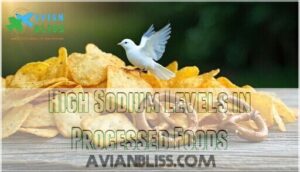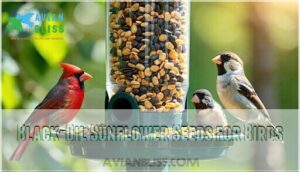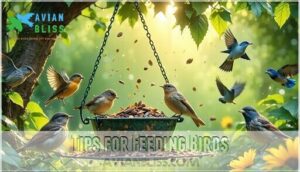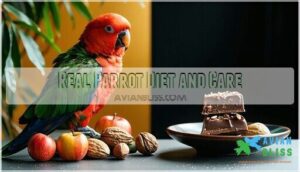This site is supported by our readers. We may earn a commission, at no cost to you, if you purchase through links.
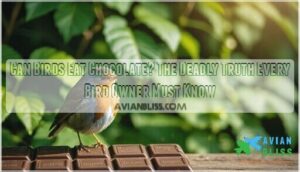
Chocolate contains theobromine and caffeine, compounds that birds can’t process the way humans do.
Even a tiny piece can trigger vomiting, seizures, or worse in your feathered friends.
Think of it this way: what’s a treat for you becomes a toxic nightmare for them.
Dark chocolate packs the biggest punch of danger, but all types pose serious risks.
Your backyard visitors and pet birds deserve much better than this deadly "treat."
Discovering the right foods that’ll keep your birds healthy and happy is simpler than you’d think.
Table Of Contents
- Key Takeaways
- Chocolate is Toxic to Birds
- Dangers of Feeding Birds Processed Human Foods
- Proper Bird Feeds for a Healthy Diet
- Tips for Feeding Birds
- Minecraft Chocolate and Parrots
- Real Parrot Diet and Care
- Frequently Asked Questions (FAQs)
- Can parrots eat chocolate?
- Can birds eat chocolate?
- Can birds eat cocoa butter?
- Why is chocolate bad for birds?
- Is white chocolate safe for birds?
- Can birds eat chocolate biscuits?
- How much chocolate is lethal for birds?
- What should I do if my bird ate chocolate?
- Are chocolate alternatives safe for pet birds?
- Can wild birds recover from chocolate poisoning naturally?
- Conclusion
Key Takeaways
- Never give chocolate to birds – it contains theobromine and caffeine, which are toxic compounds that birds can’t process, causing vomiting, seizures, heart problems, and death, even in tiny amounts.
- Dark chocolate is the most dangerous – it has the highest concentration of the deadly theobromine, but all chocolate types pose serious risks to your feathered friends.
- Choose bird-safe alternatives instead – offer black-oil sunflower seeds, fresh fruits like oranges, homemade nectar for hummingbirds, and proper commercial bird feeds for healthy nutrition.
- Keep all chocolate away from birds – just 2 grams (about the size of a chocolate chip) can be lethal, so store chocolate securely and contact a vet immediately if accidental ingestion occurs.
Chocolate is Toxic to Birds
You wouldn’t give your feathered friend a cup of coffee, so why would chocolate be any different?
Chocolate contains toxic compounds called theobromine and caffeine that can cause serious health problems or even death in birds, making it one of the most dangerous foods you can accidentally share with your pet.
Chocolate kills birds – those sweet treats contain deadly compounds that their tiny bodies simply can’t handle.
Theobromine, Caffeine, and Methylxanthines in Chocolate
Every piece of chocolate contains a deadly cocktail of methylxanthines that can kill your bird.
These compounds wreak havoc on avian systems in dangerous ways:
- Theobromine toxicity – The primary killer that birds can’t metabolize effectively
- Caffeine effects – Causes dangerous heart rhythm changes and hyperactivity
- Methylxanthine risks – Accumulates in small bodies with devastating consequences
- Dark chocolate delivers the highest concentrations, making it especially lethal
It’s also important to avoid other toxic foods such as avocado.
Symptoms of Chocolate Toxicity in Birds
Chocolate toxicity birds exhibit alarming symptoms that demand immediate attention.
Your feathered friend might experience vomiting and diarrhea within hours of ingestion.
Your bird could be vomiting and suffering from diarrhea just hours after eating chocolate.
Watch for tremors that shake their entire body, followed by dangerous convulsions.
Bird poisoning symptoms include hyperactivity, then sudden lethargy as their heart develops arrhythmia.
Avian toxicity from theobromine affects their nervous system, causing seizures and abnormal behavior.
Without emergency veterinary care, these bird symptoms can rapidly progress to death due to the severe impact of theobromine.
Dangers of Feeding Birds Processed Human Foods
When you share your favorite snacks with birds, you’re likely doing more harm than good since processed human foods lack the nutrients birds need and often contain dangerous levels of sodium.
These convenience foods can lead to serious health problems including obesity, kidney disease, and heart failure in our feathered friends.
Lack of Nutritional Value in Processed Foods
Beyond chocolate toxicity birds face another threat: processed foods that rob them of proper nutrition.
Your feathered friend deserves better than empty calories and additives harm their delicate systems.
Because of chocolate’s toxic components, it should never be given to birds.
- Bread lacks essential proteins
- Crackers contain zero vitamins
- Chips offer meaningless calories
- Cookies provide pure sugar rushes
- Cereals miss critical nutrients
These deficiencies cause serious behavioral issues and long-term effects that compromise your bird’s health permanently.
High Sodium Levels in Processed Foods
Hidden beneath colorful packaging, processed foods pack a sodium punch that’s deadly for birds.
These salty snacks cause sodium toxicity, leading to avian hypertension and kidney damage.
Your feathered friends can’t handle what we consider normal salt levels.
| Food Type | Sodium Content | Bird-Safe Alternative |
|---|---|---|
| Crackers | 200-400mg per serving | Plain seeds |
| Chips | 150-300mg per serving | Unsalted nuts |
| Bread | 100-200mg per slice | Fresh fruit pieces |
| Pretzels | 300-500mg per serving | Dried berries |
| Processed meats | 400-800mg per serving | Mealworms |
Choose salt alternatives over processed food risks.
Proper Bird Feeds for a Healthy Diet
You’ll want to focus on nutrient-rich foods that support your bird’s health instead of reaching for processed snacks or toxic treats like chocolate.
Choosing the right feeds guarantees your feathered friend gets essential vitamins, minerals, and energy while avoiding the dangerous compounds found in human foods.
Black-Oil Sunflower Seeds for Birds
Black-oil sunflower seeds pack impressive seed nutritional value that’ll turn your yard into bird headquarters. These protein-rich powerhouses feature thin shells that small beaks crack easily, unlike striped varieties that frustrate finches.
Design your feeding station with tube feeders for perching birds or ground scatter for ground-feeders. Store seeds in airtight containers to prevent spoilage.
You can find various seed products online. Different birds show distinct seed size preference – chickadees love smaller kernels while cardinals tackle larger ones.
Skip sprouting sunflower seeds for feeders since fresh, dry seeds provide ideal bird food nutrition for your feathered visitors’ bird diet needs.
Homemade Nectar Mixture for Hummingbirds
While sunflower seeds feed many birds, hummingbirds need something different.
Create a simple nectar recipe using the proper water ratio and sugar type to keep these tiny speedsters happy.
- Mix one part white sugar with four parts water
- Boil the sugar solution briefly to dissolve crystals
- Cool completely before filling feeders
- Replace nectar every 2-3 days for feeder hygiene
- Skip honey or artificial sweeteners – stick to safe alternatives
To guarantee the safety of hummingbirds, always use refined white sugar.
Oranges and Dried Fruits for Orioles, Woodpeckers, Robins, Cardinals, and Bluebirds
When offering safe alternatives to toxic foods birds shouldn’t eat, fresh oranges work wonderfully for oriole feeding and woodpecker diets.
Cut oranges in half and place them on feeders to attract these colorful visitors.
Robin treats, cardinal fruits, and bluebird snacks can include dried fruits like raisins, which provide essential nutrients.
You can find orioles’ favorite treats online.
Unlike chocolate that’s toxic to birds, these natural options support healthy diets while attracting diverse backyard species safely.
Tips for Feeding Birds
Feeding birds safely requires knowing which foods can harm them and maintaining clean feeding areas to prevent disease.
You’ll protect your feathered friends by avoiding toxic items like chocolate while keeping feeders spotless and stocked with nutritious options.
Avoiding Chocolate and Other Toxic Foods
Several toxic foods threaten your bird’s health beyond chocolate. Create a thorough Toxic Food List and establish Safe Food Swaps to protect your feathered companion.
Remember that xylitol causes liver damage, so always check the labels.
- Master Reading Food Labels – Check ingredients for hidden chocolate, caffeine, or artificial sweeteners
- Research Bird-Safe Recipes – Find healthy alternatives that satisfy your bird’s cravings
- Implement Gradual Diet Change – Slowly shift away from bird diet dangers toward proper bird food safety
Clean Feeders to Prevent Disease Spread
Dirty feeders become disease breeding grounds faster than you’d think.
Clean your bird feeders every two weeks using a 10% bleach solution to maintain proper feeder hygiene and disease prevention.
Rinse thoroughly and dry completely before refilling.
Regular maintenance with a suitable cleaning product prevents bacterial growth.
These cleaning methods protect bird health through safe practices, ensuring your feathered visitors stay healthy while avoiding other bird diet dangers.
Minecraft Chocolate and Parrots
You might’ve noticed that Minecraft allows players to tame parrots using chocolate cookies, which sparked concerns among bird owners who understand chocolate’s real-world toxicity.
Fortunately, game developers recognized this issue and promised to replace chocolate with bird-safe alternatives in future updates.
Concerns About Chocolate Taming Parrots in Minecraft
Minecraft’s chocolate taming feature for parrots raised serious concerns about chocolate misinformation and in-game toxicity.
When players feed virtual parrots chocolate cookies, it sends the wrong message about real bird care. This Minecraft parrot taming mechanic contradicts educational opportunities about chocolate toxicity in birds.
The gaming community recognized this responsible gaming issue, pushing developers to address symptoms of poor virtual pet representation. Even digital worlds should reflect real-world parrot safety and consider the impact of their game mechanics on players’ understanding of animal care, promoting a better awareness of real bird care.
Promise of Parrot-Friendly Treats in Minecraft Update
Good news rolled in when the Minecraft team addressed community concerns about chocolate toxicity.
They promised parrot-friendly treats in future updates, responding to players worried about teaching harmful feeding habits.
This update speculation centers on treat implementation that won’t mirror real-world dangers.
The gaming community pushed back against chocolate-taming mechanics, knowing chocolate kills real parrots and other birds.
Minecraft parrots deserve safe virtual snacks that don’t promote toxic feeding behaviors.
Players can expect seeds, fruits, and proper parrot behavior mechanics that educate rather than endanger.
Homemade recipes guarantee better parrot nutrition than store-bought alternatives, providing a better alternative for parrot nutrition and supporting parrot behavior that is healthy.
Real Parrot Diet and Care
Your parrot’s health depends on understanding what makes up a proper diet in the wild versus what’s toxic in your home.
Real parrots thrive on seeds, nuts, berries, and insects, but chocolate can kill them within hours due to theobromine poisoning.
Seeds, Nuts, Berries, Insects, and Larvae for Real Parrots
What makes a parrot’s diet truly nutritious? Your feathered friend needs diverse foods that mirror their wild habitat, unlike chocolate toxicity concerns that plague many bird owners.
Here’s what real parrots require for ideal health:
- Seeds with high nutritional value – sunflower and safflower seeds provide essential fats
- Nuts requiring shelling skills – walnuts and almonds offer mental stimulation
- Berries packed with antioxidants – blueberries and blackberries boost immunity
- Insect protein sources and larvae for gut health – mealworms supply essential amino acids
Dangers of Chocolate for Real Parrots
Protecting your parrot from chocolate toxicity starts with understanding the serious risks.
Dark chocolate risks are highest due to concentrated theobromine levels, but all chocolate varieties pose deadly threats.
Parrot sensitivity to theobromine poisoning means even accidental ingestion of tiny amounts can trigger seizures, heart failure, or death.
Your bird’s delicate system can’t process these compounds safely, and prevention beats treatment every time, so keep all chocolate products locked away.
Frequently Asked Questions (FAQs)
Can parrots eat chocolate?
You might think a tiny piece won’t hurt, but no—parrots can’t eat chocolate at all.
The theobromine and caffeine are toxic, causing seizures, heart problems, and even death in small amounts.
Can birds eat chocolate?
No, you shouldn’t give birds chocolate.
It contains theobromine and caffeine, which are toxic to all bird species.
Even tiny amounts can cause tremors, seizures, heart problems, and death in birds.
Can birds eat cocoa butter?
Like feeding poison to a child, you shouldn’t give cocoa butter to birds.
It contains toxic compounds similar to chocolate that can cause seizures, heart problems, and death.
Choose bird-safe treats instead.
Why is chocolate bad for birds?
Chocolate contains theobromine and caffeine, which act like poison to your feathered friend’s system.
These compounds cause tremors, seizures, heart problems, and even death – making chocolate a deadly treat you should never offer.
Is white chocolate safe for birds?
Better safe than sorry" applies here—white chocolate isn’t safe for birds either.
You’re still exposing them to cocoa butter, sugar, and potential toxins that can harm their delicate systems and cause serious health problems, which is why it’s crucial to consider the impact of potential toxins.
Can birds eat chocolate biscuits?
No, you shouldn’t feed birds chocolate biscuits. They contain toxic theobromine and caffeine that can cause seizures, heart problems, and death. Even small amounts are dangerous for our feathered friends.
How much chocolate is lethal for birds?
Just 2 grams of chocolate can kill your feathered friend.
That’s roughly the size of a chocolate chip!
Dark chocolate’s even deadlier due to higher theobromine levels.
Don’t risk it—keep all chocolate away from birds.
What should I do if my bird ate chocolate?
Act fast—contact your avian vet immediately or call an emergency animal clinic.
Don’t wait for symptoms to appear. Time’s critical here, so get professional help right away to prevent serious complications.
Are chocolate alternatives safe for pet birds?
Walking through the candy aisle feels like traversing a minefield for bird owners.
Carob treats, bird-safe "chocolate" made from cocoa-free ingredients, and commercial avian desserts offer sweet alternatives that won’t harm your feathered friend’s health, providing a safe option with bird-safe treats.
Can wild birds recover from chocolate poisoning naturally?
Wild birds can’t recover from chocolate poisoning naturally.
You’ll need immediate veterinary intervention if a bird consumes chocolate.
Their systems can’t process theobromine and caffeine, making professional treatment essential for survival.
Conclusion
Remember, the answer to "can birds eat chocolate" is absolutely never—not even the tiniest crumb.
You’re literally risking your feathered friend’s life by offering this toxic treat. Instead, stick to bird-safe options like sunflower seeds, fresh fruits, and proper nectar mixtures.
Your birds will thrive on these nutritious alternatives while staying completely safe. Don’t let curiosity about chocolate become a tragic mistake.
Keep your feeders stocked with healthy choices, and your birds will thank you with years of joyful visits.
- https://zupreem.com/toxic-foods-your-bird-should-never-eat
- https://www.petmd.com/bird/poisoning/can-birds-eat-chocolate
- https://parrotessentials.co.uk/blog/can-parrots-eat-chocolate
- https://www.reddit.com/r/parrots/comments/g37vqm/my_parrot_ate_a_little_bit_of_chocolate
- https://www.justanswer.com/bird-vet/koare-think-shiro-accidentally-ate-small-crumb-dark.html


